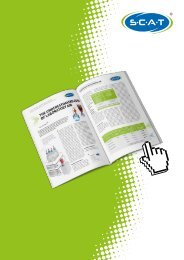SymLine Chemical Waste Systems Catalogue
Create successful ePaper yourself
Turn your PDF publications into a flip-book with our unique Google optimized e-Paper software.
Addendum I Resistance Table<br />
Resistance to chemicals<br />
Due to the wide variety and the different compositions<br />
of solvents and substances available on the market, we<br />
can assume no guarantee for chemical compatibility.<br />
As per the most up-to-date information available,<br />
materials with best resistance have been selected for<br />
SCAT products, in particular with a view to satisfying<br />
the requirements of working with aggressive fluids.<br />
Meaning of the evaluations<br />
Resistance<br />
A<br />
B<br />
Meaning<br />
Very good resistance after 30 days‘<br />
exposure, none or only mild damage.<br />
Conditional resistance: damage may occur<br />
after longer periods of exposure (e.g. hair<br />
cracks, mechanical stability affected,<br />
discolouration etc.)<br />
You may obtain information regarding compatibility<br />
with specific substances from the manufacturer of your<br />
chemicals or other expert sources.<br />
We would be pleased to offer you consultation during<br />
selection of suitable products for your application. The<br />
responsibility for the selection of the chemicals used lies<br />
with the end user.<br />
C<br />
A/C<br />
-<br />
Poor resistance: can lead to destruction,<br />
severe damage, deformation of plastic etc.<br />
There is a risk of pitting corrosion or stress<br />
cracking.<br />
Currently no information about chemical<br />
resistance available.<br />
SCAT Europe offers no guarantee for the results and<br />
assumes no obligation or liability concerning the use of<br />
these products as regards their chemical compatibility or<br />
their abrasive effects.<br />
Resistance to other available chemicals upon request.<br />
Substances (+20°) Conc. PTFE PEHD PP PFA V4A<br />
Acetaldehyde 100,00 % A B C A A<br />
Acetamide 100,00 % A A A A A<br />
Acetic acid 100,00 % A C B A A<br />
Acetic acid 90,00 % A A A - A<br />
Acetic acid allyl ester 100,00 % A A C A A<br />
Acetic acid butyl ester 100,00 % A B C A A<br />
Acetic acid-2-pentyl 100,00 % A B C A A<br />
Acetic anhydride 100,00 % A C B A A<br />
Acetone 100,00 % A A A A A<br />
Acetonitrile 100,00 % A A A A A<br />
Acetophenone 100,00 % A C B A A<br />
Acetyl chloride 100,00 % A C B A B<br />
Acetyl chloride 100,00 % A C C - A/C<br />
Acrylonitrile 100,00 % A A A A A<br />
Adipic acid 100,00 % A A A A B<br />
Allyl acetate 100,00 % A A B - A<br />
Allyl chloride 100,00 % A B C A B<br />
Aminoacetic acid 10,00 % A A A - B<br />
Aminobenzene 100,00 % A A A A A<br />
Substances (+20°) Conc. PTFE PEHD PP PFA V4A<br />
Aminomethane 100,00 % A A A A A<br />
Ammonium hydroxide 25,00 % A A A A A<br />
Amyl acetate 100,00 % A A B A A<br />
Amyl alcohol 100,00 % A A A A A<br />
Aniline 100,00 % A A A A A<br />
Anisole 100,00 % A B B A A<br />
Aqua regia 100,00 % A C C - C<br />
Aviation fuel 100,00 % A C B A A<br />
Benzaldehyde 100,00 % A B A A A<br />
Benzene 100,00 % A B B A A<br />
Benzenesulfonic acid 100,00 % A A A A A<br />
Benzoic acid 100,00 % A A A A A<br />
Benzoyl chloride 100,00 % A C C A B<br />
Benzyl alcohol 100,00 % A A A - A<br />
Benzyl chloride 100,00 % A C C A B<br />
Boric acid 100,00 % A A A A A<br />
Buta-1,3-diene 100,00 % A C C A A<br />
Butan-2-one 100,00 % A C C A A<br />
Butanedioic acid 100,00 % A A A - A<br />
Butanol 100,00 % A A A A A<br />
Butenedioic acid 100,00 % A A A A A<br />
Buthylphenol, tert. 100,00 % A B B A A<br />
Butyl acetate 100,00 % A C(B) C A A<br />
www.symline.de<br />
128


















